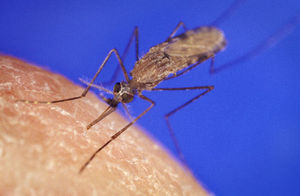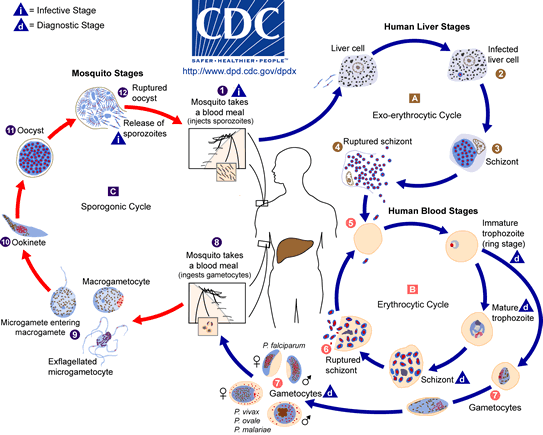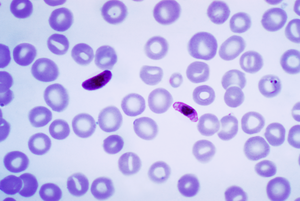Plasmodium Falciparum Control Strategies
Plasmodium Falciparum Control Strategies
International effors to address Plasmodium falciparum, a protozoan parasite that causes malaria, have been ongoing since the 1940s and 1950s12. Over half of the world's population is at risk for getting infected with Plasmodium falciparum, thereby contracting malaria1.
Malaria is a deadly disease and is estimated to be endemic in over 100 different countries1. It is also the cause of approximately one million deaths every year1.
Introduction
Background
The Plasmodium falciparum parasite lives in blood, and is of the genus Plasmodium. There are over 200 different Plasmodium species, but only 11 known types actually infect humans. Of the different species, Plasmodium falciparum is the most dangerous to humans, because it has very high mortality rates2.
The main vector for the spread of the Plasmodium falciparum parasite is mosquitoes2. There are many types of mosquitoes, but only a subset suck blood; of those, only some species are malaria transmitters. The mosquito species Anopheles gambiae (pictured at left) is one of the most efficient malaria vectors known because it transmits Plasmodium falciparum2.

Spread and Life Cycle
The Plasmodium falciparum parasite population requires both human hosts and mosquito vectors in order to perpetuate. The life cycle of P. falciparum, depicted at the right, occurs as follows:11
Mosquitoes acquire the P. falciparum parasite at first by ingesting blood from an infected human. The parasite reproduces when it enters the mosquito gut, and spreads to its salivary glands. When a mosquito punctures the skin of a human, the Plasmodium falciparum parasite enters the bloodstream by being released from the salivary glands of the mosquito. Upon entering the bloodstream, the P. falciparum is in sporozoite form. The sporozoites make their way to the liver, where they infect liver cells and multiply. They are then released into the bloodstream as merozoites, where they can infect red blood cells and reproduce asexually. As the cycle continues, infection spreads from human to human.

Effect on Mosquitoes
Plasmodium falciparum can cause behavioral changes in the mosquitoes that carry it.4 A mosquito that has acquired the P. falciparum parasite, is more inclined to feed off of a greater number of individuals in a night, and suck more blood in a single feeding than a mosquito without the parasite. This phenomenon increases the ability of Plasmodium falciparum to spread quickly through mosquitoes.
Control Strategies
There are no effective vaccines for malaria, since infected individuals don't obtain complete immunity to the infection. Any long-lasting immunity to malaria usually requires repeated exposure to the parasite2. The difficulty in creating any effective immunization is due to the parasite's ability to change the antigens it presents, which are the targets for protective antibodies2. The P. falciparum genome actually encodes fewer enzymes and transporters than other free-living eukaryotic microbes, but it encodes a high proportion of genes dedicated to evading immune responses and host-parasite interactions 3.
There are drugs which have been used to effectively treat malaria after an infection has already occured. These include chloroquine, primaquine, and artemisinin-based combination therapy (ACT)2.
Since is not possible to simply immunize at-risk individuals, the focus of malaria prevention is on reducing or controlling the spread of the disease. Research on the microbial interactions of Plasmodium falciparum and the vector which spreads it, Anopheles gambiae, sheds some light on possible approaches for malaria control.
Regulation Through Anopheles Gambiae Immune Response
The mosquito immune response can be used as a defense mechanism against malaria. An understanding of the immune system itself is a key step in this approach. When Plasmodium falciparum enters a mosquito, there is a systematic immune response5. The presence of P. falciparum gametocytes in the mosquito gut regulates the amount of gene expression occuring in mosquito guts5.

Meister et al. study the structure and function of transmembrane PGN Recognition Protein LC, which is a receptor of a signaling pathway which affects the proliferation of microbes in mosquito guts6. Their goal is to show how the PGRP-LC can regulate immune responses of mosquitoes against both Plasmodium falciparum, which infects humans, and Plasmodium berghei, which can infect rodents. They demonstrate that the connection between the defense mechanism regulated by PGRP-LC and the bacterial communities in mosquitoes can be used to control malaria transmission.
Bacterial Regulation By Environmental Influences
There have been several studies which focus on the interaction of different types of microbes with Plasmodium Falciparum. Environmental factors have been shown to be influential in the immune response of mosquitoes against the malaria-causing parasites.
Boisierre et al. study the effect of environmental factors, in tangent with natural mosquito immune response, against Plasmodium falciparum infections7. Their goal is to determine what impacts the success or lack thereof of parasite transmission by Anopheles gambiae. Through analysis of bacterial flora in the guts of Anopheles gambiae they show that the types of microbial life present are a result of the mosquito breeding sites. In addition, the presence of Enterobacteriaceae is highly correlated with the success of Plasmodium falciparum.
Dong et al. analyze infection rates of Plasmodium falciparum in the Anopheles gambiae, a type of mosquito well known for transmitting malaria8. Their goal is to better understand how microbial flora can regulate the development and transmission of malaria. They find that there are large differences between septic and aseptic mosquitos, because of the varying amounts of microbial flora that grows in their guts. The microbes help to create immune cells including anti-Plasmodium factors which may inhibit the development of Plasmodium falciparum.
Regulation By Introduction of New Bacteria
The Wolbachia pipientis bacteria, shown on the right, normally infect many arthropod species. Wolbachia pipientis bacteria do not infect Anopheles gambiae in nature. The bacteria were introduced experimentally to the Anopheles gambiae mosquitoes to test whether they could be used to control the spread P. falciparum. Experiments showed that virulent strains of the bacteria can survive and replicate when injected into a mosquito, demonstrating that viable infections are possible9. The result is hopeful, since the artificial infection of mosquitoes with the Wolbachia pipientis bacteria can negatively affect the development of malaria, as well as the mosquito population itself9. However, the use of Wolbachia pipientis to control P. falciparum is dependent on successful vertical transmission of Wolbachia pipientis in A. gambiae, which has yet to be tested.

Conclusion
Malaria is a persistent and dangerous infectious disease. By studying the most influential strain, Plasmodium falciparum, researchers have been able to better understand the mechanism of spread through Anopheles gambiae, and discover new possible approaches for malaria control.
More research is required to discover effective control methods that can be implemented on large populations, and prevent future malaria outbreaks.
References
1. Kaiser Family Foundation. "The Global Malaria Epidemic" Fact Sheet. November 2012.
11. "DPDx - Malaria Image Library"
Edited by Lydia de Pillis-Lindheim, a student of Nora Sullivan in BIOL187S (Microbial Life) in The Keck Science Department of the Claremont Colleges Spring 2013.
